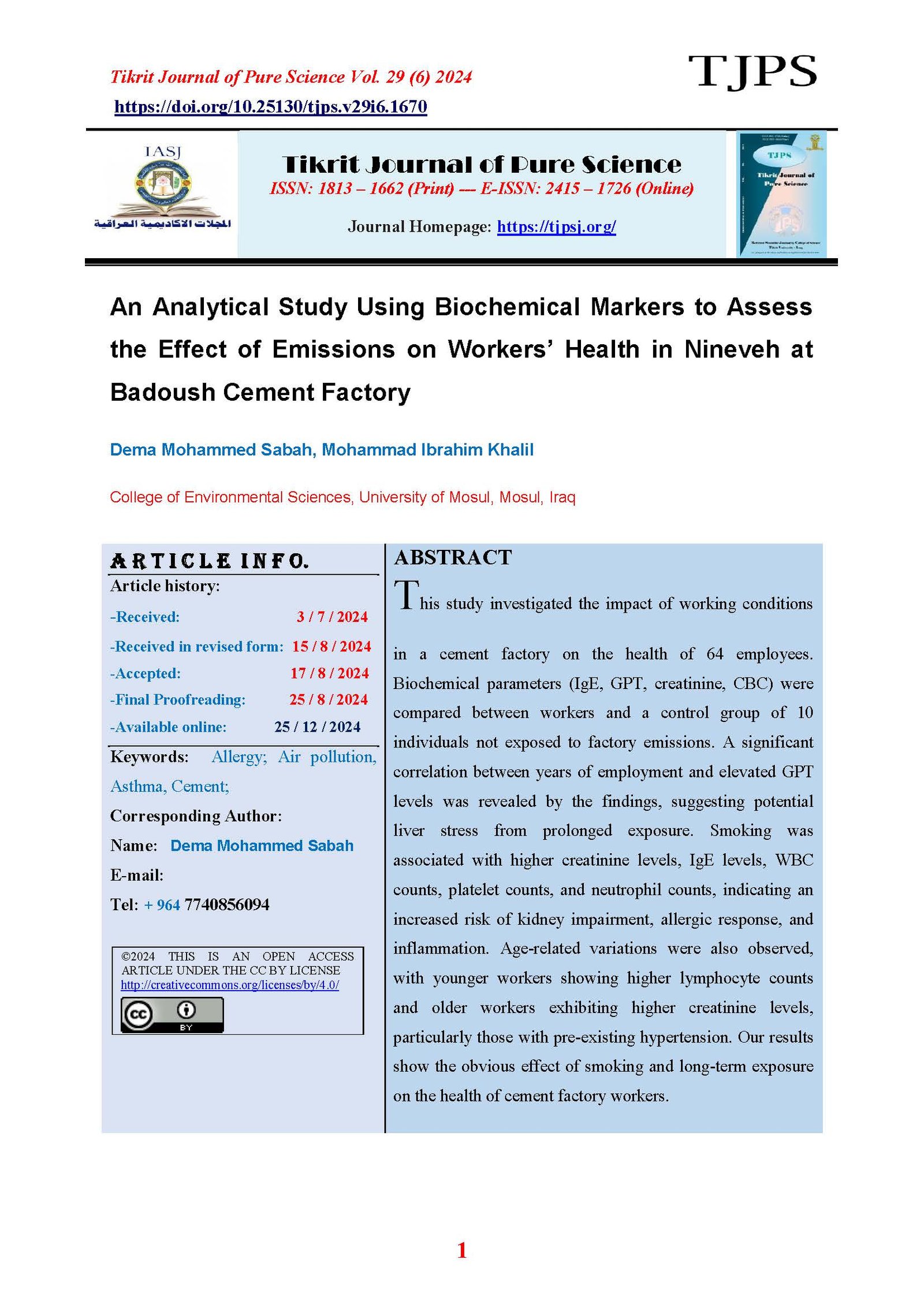An Analytical Study Using Biochemical Markers to Assess the Effect of Emissions on Workers’ Health in Nineveh at Badoush Cement Factory
Main Article Content
Abstract
This study investigated the impact of working conditions in a cement factory on the health of 64 employees. Biochemical parameters (IgE, GPT, creatinine, CBC) were compared between workers and a control group of 10 individuals not exposed to factory emissions. A significant correlation between years of employment and elevated GPT levels was revealed by the findings, suggesting potential liver stress from prolonged exposure. Smoking was associated with higher creatinine levels, IgE levels, WBC counts, platelet counts, and neutrophil counts, indicating an increased risk of kidney impairment, allergic response, and inflammation. Age-related variations were also observed, with younger workers showing higher lymphocyte counts and older workers exhibiting higher creatinine levels, particularly those with pre-existing hypertension. Our results show the obvious effect of smoking and long-term exposure on the health of cement factory workers
Article Details

This work is licensed under a Creative Commons Attribution 4.0 International License.
Tikrit Journal of Pure Science is licensed under the Creative Commons Attribution 4.0 International License, which allows users to copy, create extracts, abstracts, and new works from the article, alter and revise the article, and make commercial use of the article (including reuse and/or resale of the article by commercial entities), provided the user gives appropriate credit (with a link to the formal publication through the relevant DOI), provides a link to the license, indicates if changes were made, and the licensor is not represented as endorsing the use made of the work. The authors hold the copyright for their published work on the Tikrit J. Pure Sci. website, while Tikrit J. Pure Sci. is responsible for appreciate citation of their work, which is released under CC-BY-4.0, enabling the unrestricted use, distribution, and reproduction of an article in any medium, provided that the original work is properly cited.
References
[1] Semaa A. Shaban, Suad A. Brakhas, Ali H. Ad’hiah. (2022). Significance of total and specific IgE in asthma of Iraqi adult patients. Tikrit Journal of Pure Science, 26:1–7. doi: 10.25130/tjps.v26i1.91.
[2] Ober C, Yao T. (2011). The genetics of asthma and allergic disease: a 21st century perspective. Immunol Rev, 242:10–30. doi: 10.1111/j.1600-065X.2011.01029.x.
[3] Mims JW. (2015). Asthma: Definitions and pathophysiology. Int Forum Allergy Rhinol, 5:S2–S6. doi: 10.1002/alr.21609.
[4] Beggs PJ, Bambrick HJ. (2005). Is the global rise of asthma an early impact on anthropogenic climate change? Environ Health Perspect, 113:915–919. doi: 10.1289/ehp.7724.
[5] Wu TD, Brigham EP, McCormack MC. (2019). Asthma in the Primary Care Setting. Medical Clinics of North America, 103:435–452. doi: 10.1016/j.mcna.2018.12.004.
[6] Schuler IV CF, Montejo JM. (2019). Allergic Rhinitis in Children and Adolescents. Pediatr Clin North Am, 66:981–993. doi: 10.1016/j.pcl.2019.06.004.
[7] Dykewicz MS, Wallace D V., Baroody F, et al. (2017). Treatment of seasonal allergic rhinitis: An evidence-based focused 2017 guideline update. Annals of Allergy, Asthma & Immunology, 119:489-511.e41. doi: 10.1016/J.ANAI.2017.08.012.
[8] Katelaris CH, Beggs PJ. (2018). Climate change: allergens and allergic diseases. Intern Med J, 48:129–134. doi: 10.1111/imj.13699.
[9] Elaph M. Shuwaikh. (2023). Serological Diagnosis of Respiratory Syncytial Virus by ELISA Technique among Children with Respiratory Tract Infections in Beiji City, Iraq. Tikrit Journal of Pure Science, 28:1–6. doi: 10.25130/tjps.v28i1.1258.
[10] Ray C, Ming X. (2020). Climate change and human health: A review of allergies, autoimmunity and the microbiome. Int J Environ Res Public Health, 17:1–7. doi: 10.3390/ijerph17134814.
[11] Benhelal E, Shamsaei E, Rashid MI. (2021). Challenges against CO2 abatement strategies in cement industry: A review. J Environ Sci (China), 104:84–101. doi: 10.1016/j.jes.2020.11.020.
[12] Zeleke ZK, Moen BE, Bråtveit M. (2010). Cement dust exposure and acute lung function: A cross shift study. BMC Pulm Med, 10:19. doi: 10.1186/1471-2466-10-19.
[13] IBM Corp. (2011) IBM SPSS Statistics for Windows. Version 20.0. Armonk, NY
